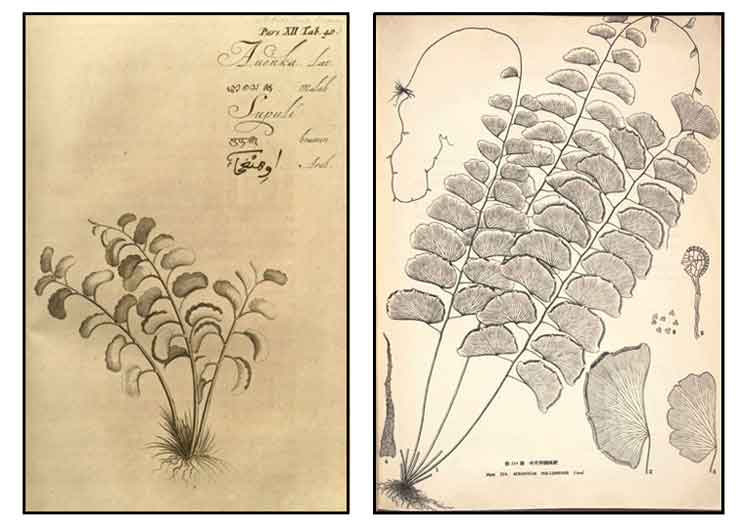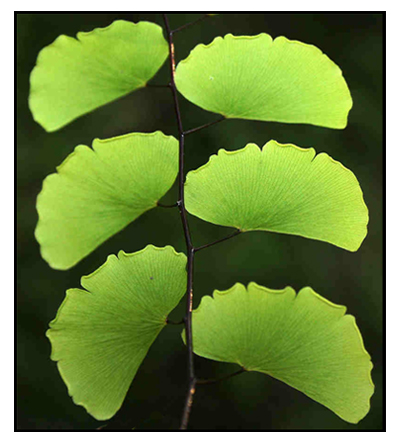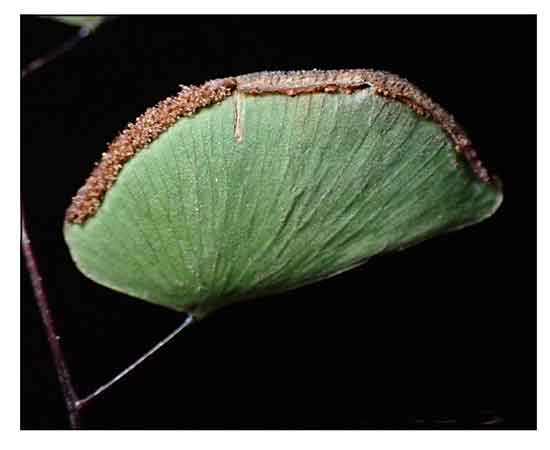 Gen info Gen info
- Adiantum, the maidenhair fern, is a genus of about 250 species of ferns in the subfamily Vittarioidea of the family Pteridaceae. Some researchers place it in its own family, Adiantaceae. (20)
- Etymology: The genus name Adiantum derives from Greek, meaning "unwetted", referring to the fronds' ability to shed water without becoming wet.
Botany
Kulantrillo is a small and delicate fern. Stipes are tufted, slender, dark brown, shining, glabrous, 5 to 20 centimeters long. Fronds are simply pinnate, leaflets are slenderly stalked, thin, oblong to semilunate in outline, 1 to 3.5 centimeters long and 0.8 to 1.5 centimeters broad, the lower margin being nearly straight or forming an angle at the insertion of the stalk, the upper margin semicircular, entire or slightly lobed. Sori are oblong to linear, and as long as the lobes are broad.
 Distribution Distribution
- Native to the Philippines.
-
On wet and damp banks or cliffs and in damp thickets, especially in the rainy season.
- Common throughout the Philippines.
- Generally distributed in the tropics.
- Some of the species are cultivated for their beautiful foliage.
Constituents
- Yields triterpene, 3,4-epoxyfilicares, flavonoids, adiantone.
- Phytochemical screening of methanol extract of leaves yielded glycosides, alkaloids, flavonoids, and saponins. Total phenol and flavonoid contents were 148.26±0.24 mg/mL and 163.06±0.56 mg/mL, respectively. (see study below)
(10)
Properties
- Considered alterative, astringent, cooling, demulcent, diuretic, emmenagogue, stomachic.
- Studies have suggested antimicrobial, antifertiliy, antihyperglycemic, antioxidant, biosorbent, thrombolytic, cytotoxic, properties.
Parts used
Fronds, fresh leaves.
 Uses Uses
Folkloric
- Fronds, either in decoction or syrup, utilized as Adiantum capillus-veneris.
- In the Philippines, administered to women in childbirth as Aristolochia species. (•) Poultice of pounded leaves applied on swellings; decoction used to alleviate stomach ache, colic, dysentery, and used as uterine tonic after childbirth. (7)
- Roots used for strangury and for fever due to elephantiasis.
- Used for febrile affections in children.
- Used for cough, leprosy, hair falling.
- Decoction of fresh leaves used as stomachic and diuretic; used as a cure for dysentery.
- In India, fronds extract used in fever, asthma, bronchitis dysentery, epilepsy, leprosy, ulcers, and erysipelas. Extract of leaves taken orally and paste of leaves applied to lower part of abdomen to clear urine. Dried rhizome mixed with water taken orally by women once during menstruation for sterility.
- In India, Pachmarhi tribal women use rhizomes as abortifacient and female contraception. Powder of dried rhizomes are mixed with water and taken orally for 3-5 days during menstruation for contraception. Decoction of fresh fronds used in abnormal or irregular menstruation. (15) Ethnic people of Tripura State use fresh leaf pastes combined with Cuscuta reflexa as contraceptive and abortifacient. (17) In Madya Pradesh, used for treatment of cough, asthma, fever, leprosy, and falling hair. (18)
- In Nepal, rhizomes were burned to generate smoke, then inhaled to treat intermittent fever. (16)
Studies
• Antimicrobial: Study evaluated the antimicrobial activity of five ethnomedicinal plant extracts against six bacterial strains S. aureus, N. gonorrhea, P. aeruginosa, E. coli, S. pyogenes, and B. subtilis. Results showed Adiantum philippense and other studied extracts could be potential sources of new antimicrobial agents. (3)
• Antifertility Effects: Study evaluated Adiantum lunulatum extract effects on reproductive structures of male albino rat. A dose-dependent and duration-dependent effect was observed on testis, epididymis, vas deferens and accessory reproductive organs of the rats. The extract affected spermatogenesis through alteration of the hypothalamus-pituitary -gonadal axis function and regulation. The structural alterations suggest an antiandrogenic property in the plant. Restoration of the histological features back to normal and reversal of functional fertility suggests essentially reversible effects. No permanent genetical loss was observed. Results suggest potential exploitation for a pharmacologically safe, effective, and reversible antifertiity agent. (6)
• Assisted Rapid Green Synthesis of Gold and Silver Nanoparticles: Ecofriendly and reliable, plants present a promising source and potential in nanoscience for drug delivery and biomedical applications. Study reports the successful synthesis of gold and silver nanoparticles using fern A. philippense. (8)
• Antihyperglycemic / Antioxidant: Study evaluated the potential of ethanolic and aqueous extracts of Adiantum philippense in hyperglycemia alloxan induced diabetic rats. Both extracts exhibited significant hypoglycemic effects when compared to glibenclamide. Both extracts also showed ABTS radical scavenging activity, increasing at increasing concentrations. (9)
• Antioxidant / Cytotoxicity / Thrombolytic / Leaves: Study on methanol extract of leaves of A. philippense showed considerable antioxidant and thrombolytic activities with minimum cytotoxicity. IC50 of DPPH scavenging activity was 140.00±0.86 µg/mL compared to ascorbic acid IC50 130.00±0.76 µg/mL. Clot lytic activity in thrombolytic assay was 12.86±1.02% compared to standard streptokinase of 30.86±0.44%. Cytotoxicity assay showed LC50 of 106.41±0.78 µg/mL vs standard vincristine sulfate of 08.50±0.24 positive control. (see constituents above) (10)
• Antibacterial / Cutaneous Infections: Study evaluated the whole plant of A. lunulatum for antibacterial potential towards bacterial species involved in skin diseases in human beings. A methanol extract exhibited maximum activity towards Pseudomonas aeruginosa resistant to amoxicillin and chloramphenicol. Activity was attributed possibly to flavonoid and phenol content. (11)
• Bioremediation Potential / Pb and Ni: From 19 terrestrial fern species, Adiantum philippense L. showed the highest and significant levels of Pb and Ni concentration in their leaves. Study results suggest potential roles in bioremediation process to mitigate concentration of heavy metals from the environment. (12)
• Biosorbent for Nickel Removal: Study evaluated Adiantum philippense as a low cost biosorbent for removing nickel from industrial biomass. Results showed A. philippense L. pinnae powder in its native form was a relatively good adsorbent for Ni(II) from aqueous solution.(13)
• Effect on Glucose Uptake
in Isolated Pancreatic Cells / Inhibition of Adipocyte Differentiation: Study evaluated A. philippense fern extract for insulin-like activity and its inhibitory role on adipocyte differentiation in 3T3-L1 cell line. In vitro results showed the AP increased glucose uptake in pancreatic beta cell as well as inhibit the maturation of preadipocytes. Mechanisms of inhibition of adipocyte differentiation may be due to decreased ability of peroxisome proliferator-activated receptor gamma (PPARy) expression. Results showed the fern has potential use as alternative medicine in managing diabetes associated with obesity. (14)
Availability
Wild-crafted.
|

![]()






